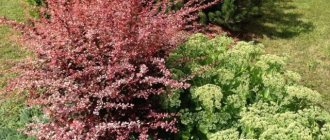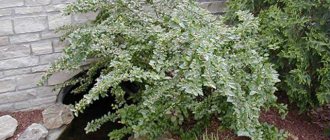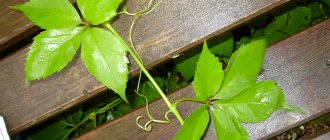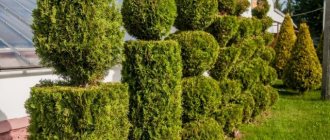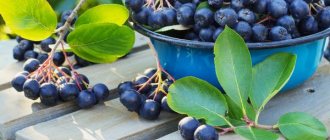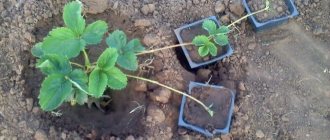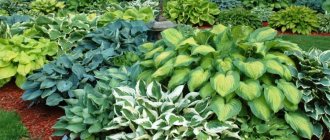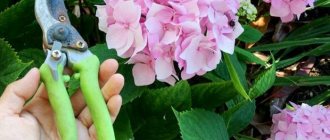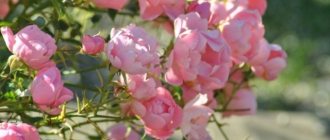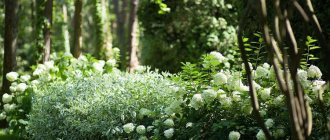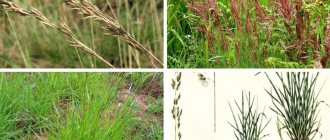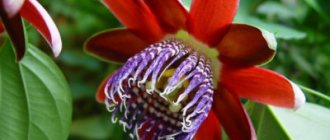Derain is a beautiful ornamental shrub that grows well in a variety of climatic zones. The family has about 50 species, among them there are deciduous and evergreen varieties. The main decoration is dense foliage, a distinctive feature is hard bark, which differs in color among different species. Variegated types of derain with two-color edged leaves look very impressive. Most representatives are grown exclusively for decorative purposes; they are actively used in landscape design or to create hedges. Planting and care will not cause much trouble; even a novice gardener can cope with this task.
Description
The main varieties of shrubs are chimeras, since at the genetic level they are a mixture of several plants, due to which the variegated turf has such an unusual appearance. The plant has the following characteristics:
- smooth stems that change color from brown to brown-red or coral with the onset of cold weather;
- the height and width of a tall plant are 3 meters, low-growing specimens reach only 1.5 m;
- the leaves are large, ovoid, regardless of color, they always have white or yellow veins or edging;
- in spring the shrub blooms with small cream-colored inflorescences;
- In autumn, fruits appear that are inedible for humans.
Photos of the variegated tree show its high decorative value, due to which it is used for landscaping park areas and personal plots. The shrub is unpretentious in care and feels great in polluted places, so it is suitable for growing within the city.
Features of the plant
Variegated dogwood has excellent decorative qualities that allow it to be actively used in landscape design in compositions and separately. Its spreading forms can reach more than 3 meters in width, but thanks to pruning, which the plant tolerates well, it can retain its clear shape for a long time. Brown-red branches, variegated iridescent leaves, and white inflorescences look very impressive and will decorate almost any landscape.
The plant has leaves that are unique in color: they are green and bordered on the sides with a white or yellow line. This combination is very rare in nature. Svidina belongs to chimeras - plants whose leaves are genetically different. Therefore, sometimes the bush begins to become covered with monochromatic leaves. You shouldn’t be afraid of this, but you need to remove purely green leaves so that their mass does not outweigh the mass of variegated ones, otherwise the plant will quickly become completely monochromatic.
Derain is a flowering shrub. Flowering time depends on the beginning of the growing season and outside temperature. Usually in May - June flowers appear, the color of which depends on the type and variety. They are collected in inflorescences measuring 5 cm or more. In September, decorative berries appear on the bush. In some species they are inedible, but in others, such as dogwood, they can be eaten.
The shrub does not require special care, so it can be used to decorate parks and squares, including in the northern regions of the country. The good tolerance of winter temperatures and the combination of different colors of the shrub make it an original decoration in the field of landscape design.
Main varieties
The variegated derain shrub has some subspecies:
- Svidina is a classic representative of the genus, which has green foliage edged with white, its height is 2-2.5 m.
- Canadian has oval-shaped foliage and is distinguished by excellent frost resistance, which makes it popular in northern latitudes.
- Blood red turf gets its name from its ability to change the color of its leaves from green to red in late summer. It has flexible and durable shoots, which is why it is widely used for making baskets.
- Kousa is distinguished by the dark green color of its leaves, which changes to bright yellow with the onset of autumn. It is one of the few varieties that has edible fruits.
- Elegantissima has shoots of a bright coral hue, which look very unusual in a composition with green-gray leaves. The plant has a height of about 2.5 m.
- Cream Cracker gets its name from the soft cream-colored edges of its leaves. With proper pruning, you can get a standard tree.
- Aurea is a shrub that is distinguished by its bright yellow leaves combined with bright red stems.
- Ivory Halo is a spherical plant, up to 1.5 m high, with classic green and white leaf colors.
- Sibirica Variegata has green foliage that turns purple in late summer. It is a low-growing plant and reaches a height of 1.2 m.
In addition to the main varieties, there are a large number of hybrids that combine several varieties of shrubs.
Use in landscape design
The shrub is extremely versatile. Planted in different ways:
- alone;
- in large, single-species groups;
- in combination with other types of wood;
- Suitable for hedges trimmed into interesting shapes or unshaped;
- looks good in a small garden (especially low-forming varieties) and in a large natural park.
High resistance to low temperatures allows turf to be planted in different regions without protecting plants from frost.
Conclusion
Cornus alba is a very attractive, widespread ornamental shrub. Derain grows easily; with minimal attention and care it will reward you with beautiful flowers. A huge advantage of this unique plant is its decorative appearance throughout the year. It stands out in the garden even before the oval leaves appear, and thanks to its red shoots it attracts attention all winter long.
The leaves look very beautiful - rounded at the base, ovoid or slightly more elliptical, densely sprouted with shoots. Often the top of the leaf is yellow or yellow-green, making an interesting accent in the garden. The underside of the leaf turns blue-green over time, enhancing the unique visual effect. In autumn, the leaves become discolored and fall off, revealing dark red and dark red shoots. For this reason, the plant is readily propagated and every gardener should find a suitable corner for it.
Choosing a landing site
Variegated dogwood is a fairly unpretentious plant, so it grows well both in partial shade and in bright sun. Fertile soil is ideal for rapid rooting and growth of seedlings; however, in its absence, the shrub takes root well on loam or sandy soils. The only strict requirement for planting is the presence of groundwater at a depth of at least 1.5 m, since the proximity of water to the root system can provoke its rotting and death of the entire plant.
The shrub is used for growing hedges. In this case, the seedlings must be planted as close to each other as possible. If you plan to grow the derain as an independent plant, then you should give it a space of about 3 m so that it feels free.
Variegated dogwood: features of planting and caring for shrubs
The shrub develops best in partial shade. The plant does well near low trees. Almost any soil is suitable, but slightly acidic soil with lime is better.
Before the landing, preparatory measures are carried out. You will need to add humus or compost to the soil. In areas where groundwater runs very close, a good drainage layer should be laid.
Since the root system of the tree is well developed, the young plant should be planted in a deep and wide hole.
Place the plant in the soil up to the root collar and no deeper, otherwise the turf will not take root and will dry out. If you plant a bush too high to the surface of the ground, then you risk getting many weak shoots. Planting is completed by thorough watering and loosening of the top layer.
Main stages of care:
- Watering. Hedge turf should be irrigated a couple of times a month. Pour no more than 15-20 liters under each bush. During dry periods, the frequency of watering increases. Intensive watering is recommended only for young bushes.
- Fertilizer. It is not necessary to feed the plant, but if you want to see all its beauty, then you cannot do without additional nutrients. Fertilize the bush with mineral preparations twice a year. It is best to do this in the spring (150 g of mixture for each plant), and use compost or humus in the summer.
- Pruning variegated tree. It is best to prune in spring. In March, shoots that are several centimeters ahead of other branches should be removed.
Hedges are trimmed twice a year. After the plant has flowered, you can remove branches that do not fit into the overall appearance. Mid-summer and late August are suitable for this.
If you plan to plant one bush of dogwood, then tie it to a stick so that the thin trunk does not become deformed.
Derain feels good in cold and frosty conditions, but this only applies to an adult plant. Young seedlings are afraid of low temperatures, so the bushes should be well covered for the winter. For this you can use both special agrofibre and ordinary bags. Plants need to be wrapped well, fixing the material at the base.
Planting rules
It is with rooting that the cultivation of variegated dogwood begins. Planting and care play an important role in this case, since this is the first stage in the cultivation of shrubs. Planting is carried out according to the following algorithm:
- it is necessary to dig a hole about 0.5 m deep and 0.3 m wide;
- the soil from the hole is mixed with humus and sand in a ratio of 1:0.5, where 0.5 are the active components, it is also recommended to add about 100 g of granular complex fertilizer for better rooting of the shrub;
- It is necessary to pour a small amount of the resulting earthen mixture onto the bottom of the hole;
- then pour about 6 liters of clean water there to moisten the soil;
- the bush is lowered into the hole and fixed in an even vertical position;
- the root system is covered with soil so that it does not look out;
- It is important to trample the soil a little;
- You can put mulch on top of the hole to retain moisture and water the plant with clean water in an amount of 5-6 liters.
Some experienced gardeners recommend pruning immediately after planting, citing the fact that after the procedure, rooting occurs more efficiently.
Subtleties of landing
It will be correct to plant turf in the spring, since in this case the plant will have the opportunity to grow over the summer, get stronger, and already prepared and full of strength go to its first wintering. In order for the turf to grow healthy and attractive and delight its owners for many years, it is necessary to choose a planting site, prepare a plot of land and purchase suitable seedlings. It is best to give preference to sunny areas. The plant can develop in the shade, but in this case the color of the leaves loses its brightness and decorativeness. Also, you should not plant the bush in places with a high groundwater level - excess moisture leads to rotting of the root system, which, in turn, leads to the death of the plant.
Pruning rules
Systematic pruning of the crown of the bush is necessary not only to give it the desired shape, but also to improve the health of the variegated tree. Planting, pruning and caring for the plant are simple. Pruning of shoots is carried out either immediately after placing the seedling in the ground or when it reaches 70 cm in height. This must be done in order to create a more branched crown. Pruning is done at the ends of young branches, which will then produce side shoots.
Formative pruning must be carried out in the spring before sap flows in the branches. At the same time, lonely plants can be given any look, and hedges are usually cut in a geometric shape. Experts also recommend anti-aging pruning once every 5 years, which involves the complete removal of old shoots.
As it grows, young branches are also pruned, which over the summer can stray from the overall shape of the bush, making it untidy. It is done using ordinary garden pruning shears.
Tree trimming
Landscape designers very often use turf in their compositions; it fits perfectly into any plantings and decorates the area on its own. Shrub trimming can be varied, depending on the owner’s preferences. The procedure is carried out in the spring and in August or early autumn. First of all, old shoots and excess growth that sticks out in the wrong direction are removed using a saw. Pruning the tree is accompanied by the rapid growth of new shoots.
Interesting! You can use wood to create arches, plant it on a fence, decorate a gate, cut it into the shape of a column, sphere or other geometric shapes.
To prevent this shrub from growing and occupying the neighboring area, pruning should be regular.
Propagation by seeds
Before planting a variegated tree, you should purchase seedlings or take care of the propagation of shrubs already existing on the site. The plant propagates by cuttings, offsets and seeds. The last method is very labor-intensive and takes an extremely long time, so it is resorted to in extreme cases.
Propagation by seeds occurs as follows:
- in the fall it is necessary to collect planting material from ripened berries;
- dried seeds are planted in light nutritious soil, watered well and covered with film until roots form;
- after this, the germinated seeds must be placed in the freezer for 2 months;
- after this period, they are removed and kept warm until germination.
Germination rate is extremely low, since not all seeds have time to ripen.
Variegated dogwood and features of its reproduction
Propagation by seeds. The plant blooms in late spring - early summer. In place of the loose buds, balls with seeds are formed. The collection of planting material should be carried out in the spring, when the boxes turn brown. As for planting them, this can be done both before frost and in the spring. If you decide to sow in May, it is recommended to store the grains in a cool place with a temperature of no more than +50 C.
Storing seeds at low temperatures increases the percentage of their germination.
Cuttings of variegated turf. The best time to take cuttings is early summer. It is not young branches that should be pruned, but last year’s branches that have dense wood. It is important to ensure that each cutting has at least three pairs of buds.
Only the upper leaves should be left on the cuttings, and the lower ones should be removed. After this, the workpieces will need to be immersed in water. They should be kept in liquid until roots appear.
The cuttings are planted in rows at an angle in a pre-made greenhouse. Specimens need to be watered regularly, but not too much. In case of dry indoor air or excess sunlight, the branches should be sprayed with water.
If everything is done correctly, then closer to autumn, the cuttings will already have full-fledged roots.
In spring, young bushes can be planted in a permanent place in open ground. To get a large mature plant, you will need to wait two years.
Shrubs are often planted as hedges. Adult specimens are trimmed to give them the desired shape and size. Variegated derain goes well in landscape design with barberry, juniper or rose bushes.
Propagation by cuttings
The most accessible and simple way is to obtain planting material by pruning the bush. How does the variegated tree propagation occur, planting and care at the cutting stage?
- To obtain seedlings, young shoots that have not yet become woody are used.
- The branches must be trimmed so that they have 3-4 internodes.
- All leaves except the top two need to be removed. The top ones determine the viability of the seedling.
- The cut is made along an oblique line and processed with a rooter.
- After this, the cuttings are planted in a pot with a nutrient mixture and watered abundantly.
You can understand how well rooting is happening by looking at the remaining leaves - they should rise and become elastic.
Types, varieties
The most popular varieties of variegated turf are:
- Elegantissima . The shrub is distinguished by the special rich color of the bark of its shoots - it is dark purple and against its background the concave leaves look very impressive. They are painted gray and have a white edge.
- Diverse Siberia . The color of the bark is less intense. It is colored green with a red tint. The green, flat leaves have a white edge.
- Gusholti . The tree of this variety forms a very massive bush, strewn with relatively small green leaves with a wide yellow border.
- Cream cracker . This is the only shrub whose crown rushes upward. It has very delicate light green leaves with a thin cream border.
Below are photos of variegated dogwood varieties in the same order in which they are described.
Reproduction by layering
What is the planting of variegated tree and caring for it at the stage of obtaining planting material by layering? To do this, a small incision is made on the young shoots in the spring and the area is covered with a little earth. If such manipulations are successfully carried out, next spring you can get a ready-made dena bush, ready for transplanting to a new place. The advantage of this method is the fact that by layering you can get quite a lot of planting material to satisfy all needs.
Landing rules
In order for the shrub to take root in a new place and delight you with its lush crown, you must follow some rules when planting.
Choice of location and lighting
The shrub grows and develops anywhere in the sun or partial shade. Varieties with bright leaves do well in a sunny area, but in the shade they lose their bright color and turn green. Considering that derain is a spreading plant, it should not be planted next to conifers and other shrubs.
Required soil
It takes root best in sandy soils, as it allows water and air to pass through well. Loam and clay soil are undesirable. It must be fertile and nutritious. The composition of the soil does not matter much. Before planting, you need to moisten the soil. If the place is swampy or the groundwater is high, then drainage is necessary. To obtain a beautiful crown, you need to apply seasonal fertilizers.
Best time to land
Immediately after the snow melts and the frosts recede, you can begin planting. In the spring, a turf with a large lump of earth is planted to preserve the root system. Autumn is suitable for replanting the plant, but it is recommended to do this after the leaves have been shed. In general, planting time does not affect development.
Watering
How is variegated tree planting and caring for it done after that? After propagation and planting, the plant is cared for by watering. The shrub does not like high humidity and may respond to it by rotting the roots. However, drought also negatively affects the appearance of the plant. The best option is to water once a week in hot weather and once every 2 weeks in cool weather. It is necessary to water the plants starting from the moment of budding; in the fall, the frequency of watering is reduced to a minimum. On average, about 10 liters of clean water must be poured into the hole under the bush at a time. In rainy weather, watering should also be reduced to avoid excessive moisture in the root system.
Rules of care
The bush requires attention. In order for it to grow quickly and delight with its beauty, it is necessary to add water on time, loosen the soil and remove weeds . If you properly care for the plant, it will not be overtaken by diseases and harmful insects. Young seedlings are watered once a week, adults - as needed. If the weather is dry, water should be added more often. One adult plant requires 20 liters.
After watering, you need to loosen the soil to remove weeds. If the plant is planted in fertile soil, the gardener does not need to fertilize. However, to improve decorative qualities, mineral compositions should be used. Requires 100 g per 1 bush. In mid-summer it is recommended to fertilize with humus. 5 kg are consumed per bush.
Plant pruning
Young crops are not pruned; pruning is recommended for plants that have reached the age of 3 years. It is recommended to thin out the shoots. Only strong branches are left on the plant . The hedge is adjusted in mid-summer , after the shoots grow. Plants with bright bark are pruned every 3 years. Haircuts should be done in the spring before the buds open.
The turf should be shortened by 20 cm. Thanks to the adjustment, the plant forms a large number of shoots and looks very beautiful. You can form bushes in the form of a cube or hemisphere. Another option is to maintain your natural shape. If you do not want to carry out formative pruning, you should perform sanitary cleaning, that is, trim off unnecessary branches.
Diseases and pests
An adult plant is resistant to diseases and pests. Young shrubs can be overtaken by powdery mildew. The main sign of the disease is a white coating. If powdery mildew is detected, the affected parts should be removed and treated with Bordeaux mixture diluted with water. Fundazol is also effective in fighting the disease.
The bush is attacked by scale insects and aphids. To expel pests, you must use one of the following drugs:
- Aktara;
- Akarina;
- Biotlin.
Top dressing
After planting, caring for variegated dogwood and other varieties of shrubs requires the application of mineral and organic fertilizers, which have a positive effect on the growth, color and appearance of plants. Fertilizing of ornamental shrubs is carried out in the spring before the start of the active growth phase. At one time it is necessary to apply about 50 g of mineral fertilizers diluted in 10 liters of water to the bush. Humus is used as organic fertilizer, which is simply laid out under the bush. It is strictly forbidden to use fresh manure, as it has high acidity, which can harm the bush.
How to grow variegated turf in a summer cottage
In the process of creating hedges, a plant such as variegated turf is most often used. It looks like a large shrub, so it can often be seen in the compositions of landscape projects. The plant is also planted in city parks and squares. Variegated turf grows quite quickly, its bark acquires an original color, and its leaves have a bright border. Caring for the plant is quite simple, so you can safely use it as a garden decoration.
Pest Control
Fortunately, the taste of variegated dogwood does not seem attractive to most pests, so only leaf rollers and aphids can attack it. These parasites are capable of destroying entire shrubs in a short time. Most often, the product “Decis” is used to kill insects, which is used for external spraying of plants. Gardeners also note the effectiveness of using a solution of grated laundry soap for these purposes (72%), to prepare it you will need 1 piece (based on 10 liters of liquid). A spray bottle is used as a sprayer.
Diseases and pests of variegated dogwood
Dogwoods are in excellent health. Almost all pests bypass the eastern guest, and fungal diseases, characterized by various spots and the presence of rotting areas, appear from improper care. Among the pests, only aphids are noted; occasionally snails and slugs attack the crown. Aphids are exterminated using systemic insecticides or folk methods - soap solution, infusion of garlic, hot pepper, dandelion. If you use prickly materials as mulch, the snails will not be able to get close to your green pet. Another simple way is to collect them manually, set traps or use special preparations to kill them.
On a note! Slugs are afraid of the smell of bleach. Pour “Whiteness” into a small container and place it next to the eastern guest.
In case of fungal diseases, adjust the irrigation regime. Wait until the soil dries before watering again. Trim damaged branches, treat the infected specimen with a fungicide - Fitosporin, Fundazol.
Variegated dogwood: nuances of cultivation
The shrub looks decorative throughout the growing season. Its strong branches of brown-red color, variegated leaves, white flowers and blue berries look very beautiful. Since the crop is frost-resistant, it is often used for landscaping gardens and parks in the northern regions of the country.
In order for a plant to fully reveal its decorative properties, it needs to be provided with suitable conditions. Derain is unpretentious and will grow anywhere, but poor conditions directly affect its decorative properties.
Derain hedge
Derain grows well in any conditions, and therefore the list of options for its use in landscape design is quite extensive. For example, you can often see turf as a background for a bright flower bed, the flowers in which will look more interesting.
Shrubs are also planted under trees whose branches start very high. In this case, the bush decorates the trunk and also protects it from the winds.
The bush is often used as a decoration for large mixed borders to create a living wall.
As we said earlier, a hedge made of wood is an excellent solution.
The plant can also be planted on the ground in the form of terraces. You just need to trim the bushes regularly so that they have a presentable appearance.
How to propagate turf?
The shrub can be propagated in different ways:
- seeds;
- cuttings;
- layering.
Three-year-old plants are already bearing fruit and producing seeds. Seed germination is high. Seed material collected in the garden is usually planted in the fall, and prepared stratified material is planted in the spring. For seeds you need to prepare a substrate of sand, moss and sawdust. Seeds planted in the substrate must be kept at a temperature of +5 for 8 weeks. After this, the seeds can be planted to a depth of no more than 5 cm. This method is very labor-intensive. It will take at least 5-7 years for a seedling grown from a seed to reach standard size.
To preserve all the characteristics of the decorative form of the shrub, it is better to propagate it vegetatively.
Under the bark of each shoot there are root rudiments, so you can use not only green but also lignified cuttings. Spring pruning of the bush just gives you the opportunity to stock up on the required amount of cuttings. Each shoot should have at least 7 well-developed buds. The prepared material is placed in trays with a pre-prepared substrate and placed in a warm place. Timely watering and fertilizing will do their job, and by September the seedlings will be completely ready for planting in the ground.
In order not to bother with cuttings, you can use a simpler method. In spring, it is enough to sprinkle with soil and fix several shoots in this position. After a year, they can be separated from the mother plant and planted in a new place.
Description of white wood
In botanical literature you can often find the following synonymous names for this plant:
- White dogwood.
- White pork.
- Svida is white.
- The telescreen is white.
White dogwood (Cornus Alba) is a perennial deciduous shrub with straight shoots. Belongs to the Kizilov genus, the Kizilov family.
The main characteristics of white wood are shown in the table.
| Parameter | Meaning |
| Escapes | Smooth, arched in old age, various shades of reddish (in spring - bright red) color. |
| Leaves | Elliptical, with a smooth edge, up to 10 cm in length and up to 7 cm in width. The petioles are short, up to 1 cm. 3-5 arcuate veins are clearly visible on the leaf blade. The leaf blade is dark green above, bluish below, pubescent on both sides. |
| Flowers | Corollas with 4 petals are white, collected in dense shields up to 5 cm in diameter at the ends of the shoots. |
| Fruit | Inedible drupes are bluish in color, when ripe they are white or slightly bluish. |
| Spreading | From the North-Western part of Russia to the Far East. Found in Western Europe, Mongolia and Japan, China and Korea. |
White tree crown diameter
An adult white dogwood bush can reach significant sizes. Individual specimens can grow up to 5 m in diameter. Often nearby bushes intertwine with each other, forming impenetrable thickets. This feature of white dogwood is used by landscape designers when creating hedges.
White tree height
Separately standing shrub bushes can grow up to 3 m in height. In ornamental gardening and landscape design, their growth is often artificially limited by cutting shoots at a height of 1.5-1.7 m and giving them a rounded shape.
How fast does white turf grow?
White dogwood is characterized by rapid growth of shoots. Over the course of a year, their length can increase by 0.5 m or more, depending on care and weather conditions.
Distinctive features of variegated turf
This plant was bred artificially. The shrub has spreading branches and a large crown in diameter. Adult shoots turn red.
Do not be afraid to replant the turf, since it adapts to any growing conditions very quickly.
The leaves of the shrub are distinguished by a green tint, which can have a light or dark tint. The upper part of the plates is covered with a pattern of yellow, golden and white tones.
The flowering of variegated turf is long and colorful. During the year it can be observed twice - at the beginning of summer and in September.
Planting derain
Gardeners often choose this particular plant because of its unpretentiousness. Here are some of its positive aspects:
- Frost resistant
- Can take root in almost any soil area
- Calmly relates to high humidity levels and too low
- Behaves positively despite various environmental factors
If we talk about how to plant turf correctly, then this should be done in areas where there is a lot of sun. But an area where there is a little shade is also suitable. The plant is very rarely exposed to diseases and pests. This fact can also be added to its advantages.
Derain white
Still, when getting down to work, you should familiarize yourself with some of the details of its planting. Despite its unpretentiousness, it is best to enrich the soil with fertilizers before planting. For this purpose, organic bait - humus and compost - is poured into the hole. When the area is swampy or groundwater runs high, it is recommended to carry out drainage.
Some people buy already grown seedlings. In this case, it is better to buy those that are no more than 4 years old, because they will be able to take root faster and will produce more new shoots when pruning is done. When you plant it, pay special attention to inspecting the roots. If they are dry, it is better to place them in water for a couple of hours or more until they absorb moisture. After this procedure, the likelihood of successful engraftment increases.
To continue cultivating a plant, there are two ways to propagate it - fast and slow. For slow growth, seeds are used. The quick method uses cuttings, layering and seedlings.
